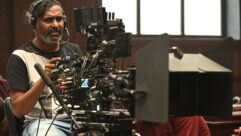QUESTION OF BALANCE
May 1, 1999 12:00 PM,
Peter H. Putman
Video and coaxial cable. The two seem to go together like soup andsandwich. In fact, we have been using coaxial cable with video signals forso long that it almost seems as though both made their appearancesimultaneously. You can just imagine the big black cables snaking away fromhuge image orthicon TV cameras, covering a day baseball game in the late’30s.
Well, coaxial cable may be the most expedient way to move video (and audio)signals around, but it is not necessarily the best, nor is it the only way.To understand why, let’s step back a little bit and review some basicelectrical physics.
Back and forthEvery analog A-V signal we pump through an installation-audio, video,computer-is essentially an alternating current (AC) signal. The frequencymay vary, as will the intensity. Aside from those differences, however, allwe are doing is switching and moving a lot of AC voltages. By using suchtricks as bandpass/band reject filters, we can send more than one of thosesignals at a time.
Stop and think about this for a moment. An AC signal is really twodifferent DC signals with opposite phases. For one half of the cycle, halfthe voltage is present. In the other half of the cycle, the rest of thevoltage is present. And so we go along, swinging merrily from peak to peakand from source to load.
To move a DC signal, you really do not need anything more than a pair ofwires-one for the positive side and one for the negative side. Because anAC signal is really an oscillating DC signal, it is no more demanding aboutcabling than its DC cousin; two wires are fine. That is exactly how RFenergy was first handled in the early days of the century-using a pair ofwires spaced a precise distance apart to couple energy from a transmitterto an antenna.
Open-wire transmission is indeed the lowest-loss method of moving ACsignals from point to point. For many years, TV sets used 300 V ribbon wireor 450 V ladder line to connect antennas to TV sets. In this world of cableand direct satellite television, that may be hard to believe, but open-wireline is still the best way to move RF signals because the lowest-lossdielectric available is still air.
There are, however, the usual caveats. First, the cable cannot getexcessively wet or covered with snow, ice or semi-conducting fluids. Next,it cannot rest on or come in close proximity to such metal objects asgutters, flashing, windows, ducting, screens and pipes. Finally, open-wireline does not like to be bent at severe angles; gentle, long-radius curvesare all it can tolerate.
It is easy to see why coaxial cable came into existence. We run cablesalongside plenty of metal objects, often burying them in hostileenvironments. We put all kinds of twists and turns into cable (not tomention splices) and even tie it into loops. That kind of path is anightmare to negotiate with ladder line.
On the other hand, there is a problem. The AC voltages in coaxial cablewant to travel as if they are still flying along open-wire transmissionlines. Electrically, that is not a big issue-one leg flows in the centerconductor, and the other flows in the outer shield. The problem occurs whenthese AC signals arrive at their load-anything from a loudspeaker orantenna to a resistor, splitter or amp-and one side is grounded. Most ACloads are designed to function as balanced components, and most antennasuse a dipole radiator as the driven element.
Connecting that unbalanced, grounded transmission line (coaxial cable)directly to a balanced load can result in all kinds of problems, such ascurrents flowing back down the shield to the source. These stray currentscreate standing-wave problems, resulting in a mismatch from the cable tothe load. The result can be ringing or ghosting, not to mention unwantedradiation of the signal from the coaxial cable, which is now working aspart of the load.
On the levelThe solution is to use a small transformer to convert from an unbalanced toa balanced signal, and vice-versa. This transformer is known as a balun,and there are literally millions of them in operation around the worldevery day, matching everything from telephone lines to transmitters. Balunsare used both to soft out the flow of AC signals and make the necessaryimpedance transformation between coaxial cable, which has a low impedance,and balanced loads, which have higher impedances.
With a balun, I can now send AC signals of any kind over a pair of wiresand make the necessary transformations at either end to effect a cleantransfer of AC signals. For connecting a 200 V balanced load to a 50 Vcable, use a 4:1 balun. Additionally, 75 V coax to 300 V twin lead (acommon CATV connection twenty years ago) requires a 4:1 balun. Althoughthis is a common turns ratio, you can also wind 2:1, 6:1, 8:1 and even 10:1baluns if necessary.
At RF frequencies, the use of a balun is imperative for proper matching oftransmitters and antennas. If not, unwanted current flow and mismatches canactually increase interference to adjacent electronic equipment throughstray coupling into power lines, audio cables and antennas. What aboutbaseband video? If everything in the A-V installation uses BNC or RCAjacks, what is the big problem?
Well, here is a plausible scenario. Assume that you have been asked toretrofit an existing training room with video and audio playback. Runningnew coaxial lines will be a tedious, costly job requiring structuralmodifications. After some technical nosing around, you discover there are aconsiderable number of unused twisted-pair lines already in place, such asCat3 or Cat5 structured UTP cable. Great. What good are they?
With the use of a balun, those seemingly superfluous wires can be convertedinto open-wire transmission lines to carry audio and baseband video fromone point to another with little difficulty. As long as the pair of wiresruns straight without encountering any splices or interruptions, you are inbusiness. Simply add another balun at the destination to convert thesignals back to regular coaxial cable.
The point to understand here is that if you have achieved a truebalanced/unbalanced transformation, your video signal will not even notice.The balun prevents an impedance bump from occurring at the point oftransition, although there will be a little signal loss in the transformer.This can be minimized by using high-efficiency, high Q cores made fromadvanced ferrites and ferrite composites.
For audio signals , you can mix them with video signals on the same line byusing different windings on the balun. For a 600 V audio pair, thetransformation might need to be 4:1 or 6:1. The balun also acts like anisolation transformer to eliminate the possibility of common-mode currentflows (also referred to as ground loops) that generate hum and rollinginterference bars.
By adding inductors and capacitors to the balun, we can multiplex video andaudio on the same line pair using low-pass, high-pass and bandpass filtersto separate the video from the audio. This 50-year-old trick was (and stillis) used to couple RF from AM radio transmitters into AC power lines anduse those lines as low-efficiency, limited radiation broadcast antennas incollege dormitories.
As for the problem with bending and close-coupling of open-wire lines, thecause is a phenomenon known as skin effect. As AC signals increase infrequency, they have an increased tendency to move along the surface orskin of a conductor instead of through it. This is why signal attenuationis so much higher for a given piece of coaxial cable than comparableopen-wire line at RF frequencies. The coaxial dielectric is absorbing anincreasing amount of the energy, leading to the use of pure air dielectricsat microwave frequencies.
With baseband video, skin effect is much less pronounced, although there isstill some signal loss due to capacitive and inductive coupling intoadjacent wires. In addition, you will see greater signal attenuation usinga balun to match 4 MHz baseband video into Cat3 or Cat5 wire than if youcoupled into pure open-wire transmission line with an air dielectric oreven conventional RG-59/RG-6 coaxial cable.
The amount of signal loss will be largely dependent on the quality of thewiring and the distance of the run, although one manufacturer figures about6.6 dB per 1,000 feet @ 1 MHz for AWG#24 Cat3 wire (6.6 dB per 305 m @ 1MHz). Contrast this number with Belden 8281, a workhorse RG-59/U videocable that exhibits 2.5 dB loss per 1,000 feet @ 1 MHz or Belden 9085, a300 V open-wire transmission line that attenuates 1.4 dB for every 100 feet@ 100 MHz.
Theoretically, you could run RF-modulated video at higher frequenciesthrough Cat3 or Cat5 wire, but you would have to expect great losses at thereceiving end as well as ghosting (signal cancellation due to phasing andstanding-wave errors) and high-frequency rolloff. Consequently, basebandvideo is the best way to go with a hybrid coax-to-structured wiring system.
Baluns to goOne company already offering products for coax-to-Cat3 (or Cat5)transitions is Intelix, Middleton, WI, which has four different balunproducts available that require nothing more than plugging them in. Becausebaluns are passive devices, they do not require any electrical power tooperate, and you can place them in more remote locations duringinstallation.
Intelix’ V1 is perhaps the simplest product, looking like a humped box witha BNC plug on one end and RJ45 jack on the other end. It is used forconnection of one composite video signal (two required for a fulltransition). A companion product, the V3 Video Balun, accepts an RGsBcomponent signal and converts it to an RJ45 jack. For multiplexing, Intelixoffers the V2A2 A-V balun for two-way transmission of composite video andaudio signals, and the V1A2 combines a single BNC composite plug jack andtwo RCA jacks for stereo audio. Again, both baluns convert to RJ45terminations.
According to Intelix specifications, Cat3 and Cat5 wire pairs have acharacteristic impedance of 100 V @ 1 MHz, requiring a 6:1 balun for audioand about a 1.5:1 match for video, although a straight 75 V to 100 Vconnection will result in only 4% reflected power coming back at the videosource. Intelix also claims a bandwidth of 10 MHz and audio frequencyresponse of 20 Hz to 22 kHz for its baluns.
With respect to signal attenuation, under ideal circumstances, Intelixadvises a maximum cable run of 1,300 feet (40 m) for sending colorcomposite video down Cat3 wire and 2,000 feet (622 m) down Cat5.Black-and-white signals (and audio) can be safely strung as far as 2,000 ft(622 m) on Cat3 pairs and 2,500 ft (762 m) on Cat5. Things become a littlemore restricted for RGsB signals, which can only be sent about 300 ft (91m) along Cat3 pairs and 500 ft (152 m) on Cat5. It would appear that Y/Cvideo could be ported along two of the three inputs on a V3 Video Balun,but Intelix provides no information on such a connection.
Is it worth using Cat3 and Cat5 cable exclusively for video wiring? Thatapproach would surely make cabling a lot simpler, but if you had a choice,it would be prudent to stick with conventional coaxial cable and plenumwire whenever possible. Still, one advantage of a balun would be in atemporary hook-up, such as running a decoded videoconference signal tomultiple classrooms.
Video from desktop PCs that is scan-converted to a composite signal couldalso be sent along structured lines, an approach that might come in handyin media classrooms where wire pulls are already in place and cannot beenlarged. You could also feed video from a remote camera back to a videorecorder or server via structured wire.
The truth is, if you have any constant-impedance twisted-pair wire-evenolder plenum cable -and you know the characteristic impedance (availablefrom the cable manufacturer), you can wind a balun to match it to coaxialcable and use that twisted-pair wire as a transmission line for basebandvideo. As mentioned earlier, AC are not necessarily affected by the mediumthrough which they travel if we keep the transitions orderly and smooth. Ifthe signal loss figures are acceptable, feeding video through a balun tostructured wiring might just be the ticket for that seeminglyovercomplicated retrofit installation.










